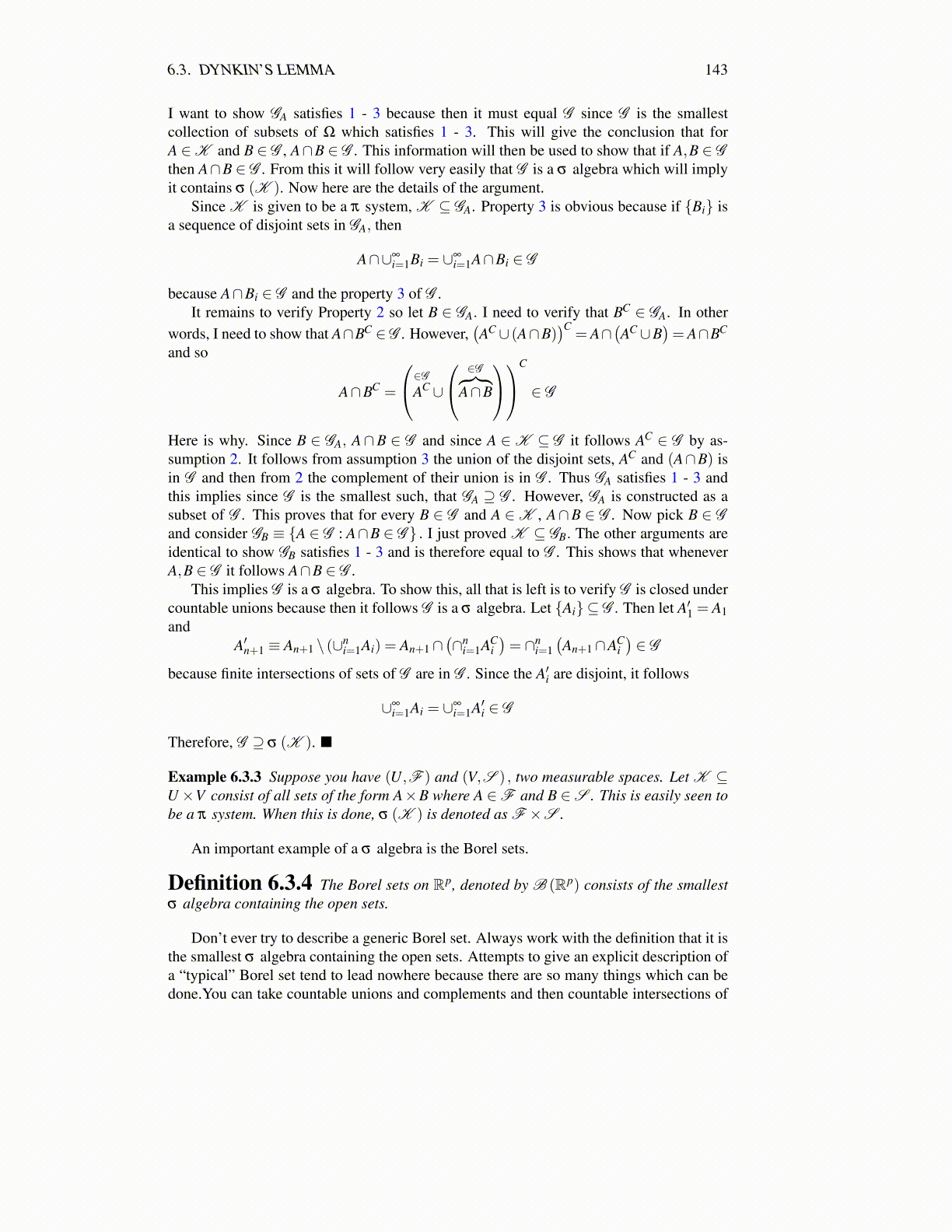
6.3. DYNKIN’S LEMMA 143
I want to show GA satisfies 1 - 3 because then it must equal G since G is the smallestcollection of subsets of Ω which satisfies 1 - 3. This will give the conclusion that forA ∈K and B ∈ G , A∩B ∈ G . This information will then be used to show that if A,B ∈ Gthen A∩B ∈ G . From this it will follow very easily that G is a σ algebra which will implyit contains σ (K ). Now here are the details of the argument.
Since K is given to be a π system, K ⊆ GA. Property 3 is obvious because if {Bi} isa sequence of disjoint sets in GA, then
A∩∪∞i=1Bi = ∪∞
i=1A∩Bi ∈ G
because A∩Bi ∈ G and the property 3 of G .It remains to verify Property 2 so let B ∈ GA. I need to verify that BC ∈ GA. In other
words, I need to show that A∩BC ∈ G . However,(AC ∪ (A∩B)
)C= A∩
(AC ∪B
)= A∩BC
and so
A∩BC =
∈GAC ∪
∈G︷ ︸︸ ︷A∩B
C
∈ G
Here is why. Since B ∈ GA, A∩B ∈ G and since A ∈K ⊆ G it follows AC ∈ G by as-sumption 2. It follows from assumption 3 the union of the disjoint sets, AC and (A∩B) isin G and then from 2 the complement of their union is in G . Thus GA satisfies 1 - 3 andthis implies since G is the smallest such, that GA ⊇ G . However, GA is constructed as asubset of G . This proves that for every B ∈ G and A ∈K , A∩B ∈ G . Now pick B ∈ Gand consider GB ≡ {A ∈ G : A∩B ∈ G } . I just proved K ⊆ GB. The other arguments areidentical to show GB satisfies 1 - 3 and is therefore equal to G . This shows that wheneverA,B ∈ G it follows A∩B ∈ G .
This implies G is a σ algebra. To show this, all that is left is to verify G is closed undercountable unions because then it follows G is a σ algebra. Let {Ai} ⊆ G . Then let A′1 = A1and
A′n+1 ≡ An+1 \ (∪ni=1Ai) = An+1∩
(∩n
i=1ACi)= ∩n
i=1(An+1∩AC
i)∈ G
because finite intersections of sets of G are in G . Since the A′i are disjoint, it follows
∪∞i=1Ai = ∪∞
i=1A′i ∈ G
Therefore, G ⊇ σ (K ). ■
Example 6.3.3 Suppose you have (U,F ) and (V,S ) , two measurable spaces. Let K ⊆U×V consist of all sets of the form A×B where A ∈F and B ∈S . This is easily seen tobe a π system. When this is done, σ (K ) is denoted as F ×S .
An important example of a σ algebra is the Borel sets.
Definition 6.3.4 The Borel sets on Rp, denoted by B (Rp) consists of the smallestσ algebra containing the open sets.
Don’t ever try to describe a generic Borel set. Always work with the definition that it isthe smallest σ algebra containing the open sets. Attempts to give an explicit description ofa “typical” Borel set tend to lead nowhere because there are so many things which can bedone.You can take countable unions and complements and then countable intersections of